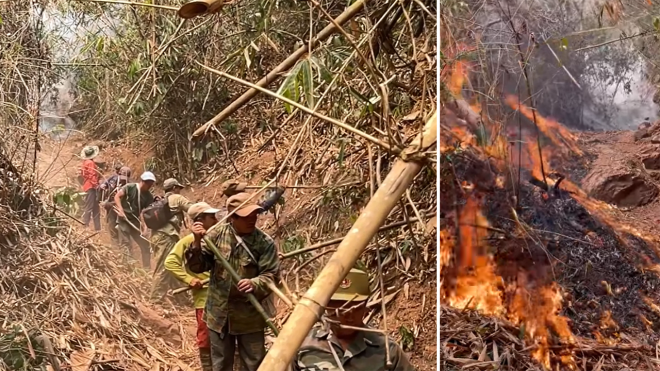
Forest fires in northern Laos have burned up to half of forested land in some areas as wildfires spread in parched, hard-to-reach hilly areas due to a lack of modern firefighting equipment, authorities said.
Fires fanned by drier-than-usual weather in Luang Prabang, Xayabury and Oudomxay provinces have been burning for weeks, causing respiratory problems and some of the region’s worst smog in years.
Many of the fires began as controlled burns started by farmers using slash-and-burn agriculture techniques to clear land for the beginning of planting season in May.
Some villagers are tying together tree leaves and branches to make a broom to try to keep fires from spreading, a fireman from Luang Prabang province told RFA.
“They’re using sticks to fight fires,” he said.
 Hundreds of wildfires on a single day – April 18, 2023 – in northern Laos are represented by red dots in this satellite image. Credit: NASA FIRMS
Hundreds of wildfires on a single day – April 18, 2023 – in northern Laos are represented by red dots in this satellite image. Credit: NASA FIRMS
‘Some places, there’s no water’
Most firefighters in Laos have out-of-date equipment and are underfunded, a rescue official in Oudomxay province told Radio Free Asia. Laos’ government doesn’t use airplanes or drones to monitor or extinguish fires like they do in other countries, he said.
“If the place of wildfire is steep and hilly and a firetruck can’t reach it, villagers use the tree branches,” he said. “Some places, there’s no water and a fire truck can’t do anything.”
Other fires have started in forests and then spread to nearby farms, according to an official in Luang Prabang province’s Vieng Kham district.
“At the farms, the fires are burning things left over after the harvest, like corn cobs and dry trash, including decayed fences and old water hoses,” the official told RFA last week.
In Oudomxay province’s Xay district, between 45% and 50% of forest has recently been destroyed by wildfires, a local official said. Villagers and firefighters worked together to contain the fires, preventing damage to homes, farms and cattle, he said.
More than 320,000 hectares were destroyed by wildfire between 2014 and 2022, according to the Ministry of Forestry and Agriculture. Most of the damage was due to the annual slash-and-burn fires that spread elsewhere, the ministry found.
Translated by Sidney Khotpanya. Edited by Matt Reed and Malcolm Foster.
